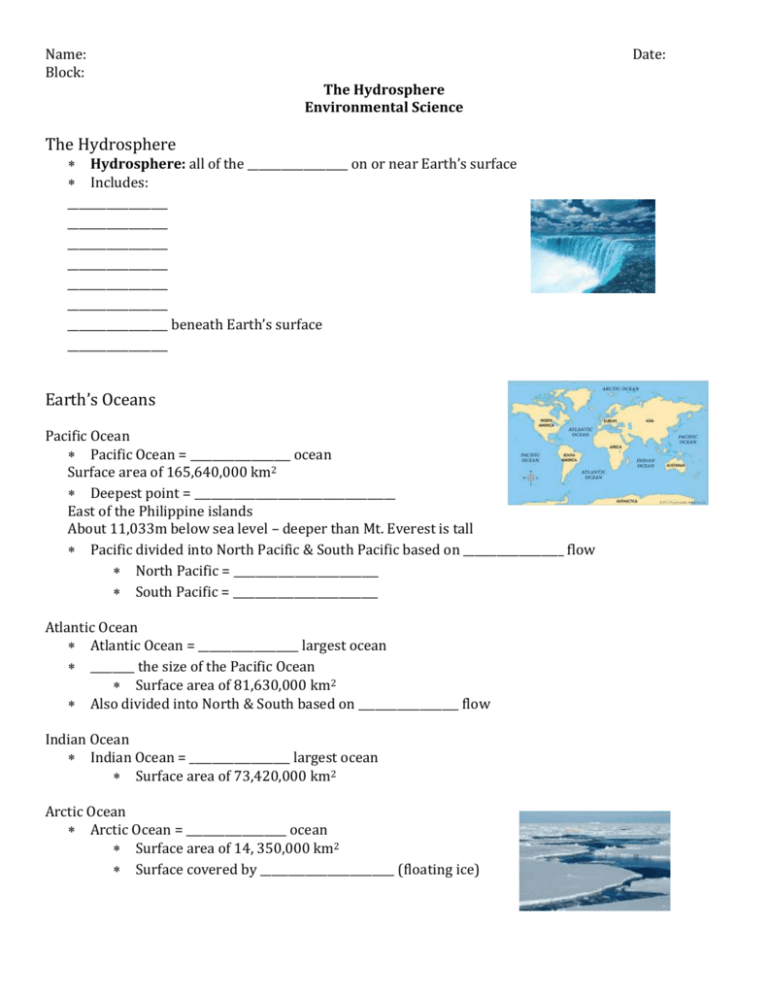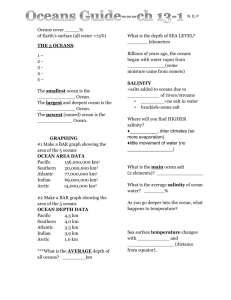notes
advertisement

Name: Block: Date: The Hydrosphere Environmental Science The Hydrosphere Hydrosphere: all of the __________________ on or near Earth’s surface Includes: __________________ __________________ __________________ __________________ __________________ __________________ __________________ beneath Earth’s surface __________________ Earth’s Oceans Pacific Ocean Pacific Ocean = __________________ ocean Surface area of 165,640,000 km2 Deepest point = ____________________________________ East of the Philippine islands About 11,033m below sea level – deeper than Mt. Everest is tall Pacific divided into North Pacific & South Pacific based on __________________ flow North Pacific = __________________________ South Pacific = __________________________ Atlantic Ocean Atlantic Ocean = __________________ largest ocean ________ the size of the Pacific Ocean Surface area of 81,630,000 km2 Also divided into North & South based on __________________ flow Indian Ocean Indian Ocean = __________________ largest ocean Surface area of 73,420,000 km2 Arctic Ocean Arctic Ocean = __________________ ocean Surface area of 14, 350,000 km2 Surface covered by ________________________ (floating ice) Ocean Water Ocean water contains __________________ __________________: measure of amount of dissolved salts in a given amount of liquid Lower in places with a lot of __________________ Higher where water __________________ quickly Most salt is _________________________________ (____________) Temperature Zones Surface of oceans is warmed by the __________________, depths are just above __________________ 3 layers: __________________ zone, ________________________, __________________ zone Global Temperature Regulator Oceans absorb & store energy from the __________________, which regulates ________________________ temperature Oceans absorb & release heat __________________ than land __________________ temperatures are regulated by oceans Ocean Currents __________________ currents: stream-like movements of water at or near the surface of the ocean __________________ driven May be warm or cold, but do not mix __________________ currents: stream-like movements of water that flow very slowly along the ocean floor __________________, __________________ water from the poles sinks below __________________ water Fresh Water & River Systems Fresh water: water that contains insignificant amounts of __________________ Most trapped in __________________ and __________________ Also found in __________________, __________________, __________________, __________________, & the __________________ Groundwater Groundwater: collection of water from __________________ & melting __________________ that runs off the land & trickles through the ground Makes up ________% of the Earth’s water Supplies __________________ water as well as __________________ & __________________ needs Aquifers Aquifers: __________________ layers that store & allow the flow of __________________________ The Water Cycle The Water Cycle: continuous water movement __________________ __________________ __________________ __________________ Evaporation: change of a substance from a __________________ to a __________________ Most water evaporates from __________________ Condensation: change of a substance from a __________________ to a __________________ Water vapor forms droplets on dust particles, which forms __________________ Precipitation: any form of water that falls to the Earth’s surface from the __________________ Includes __________________, __________________, __________________, & __________________






